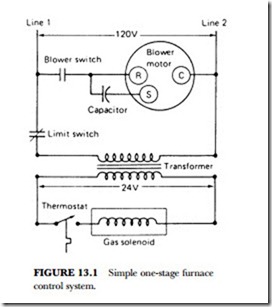Hot-air furnaces are self-contained and self-enclosed units. They are usually centrally located within a build- ing or house. Their purpose is to make sure the temperature of the interior of the structure is maintained at a comfortable level throughout. The design of the furnace is determined by the type of fuel used to fire it. Cool air enters the furnace and is heated as it comes in contact with the hot metal heating surfaces. As the air becomes warmer, it also becomes lighter, which causes it to rise. The warmer, lighter air continues to rise until it is either discharged directly into a room, as in the pipeless gravity system, or is carried through a duct system to warm air outlets located at some distance from the furnace.
After the hot air loses its heat, it becomes cooler and heavier. Its increased weight causes it to fall back to the furnace, where it is reheated and repeats the cycle. This is a very simplified description of the operating principles involved in hot-air heating. And it is especially typical of those involved in gravity heating systems. The forced-air system relies on a blower to make sure the air is delivered to its intended location. The blower also causes the return air to move back to the furnace faster than with the gravity system.
With the addition of a blower to the system, there must be some way of turning the blower on when needed to move the air and to turn it off when the room has reached the desired temperature. Thus, electrical controls are needed to control the blower action.
BASIC GAS-FURNACE OPERATION
The gas furnace is the simplest to operate and understand. Therefore, we will use it here to look at a typical heating system. This type of natural-gas furnace is used to heat millions of homes in the United States.
Figure 13.1 shows a simple circuit needed to control a furnace with a blower. Note the location of the blower switch and the limit switch. The transformer provides low voltage for control of the gas solenoid. If the limit switch opens (it is shown in a closed position), there is no power to the transformer and the gas so- lenoid cannot energize. This is a safety precaution, because the limit switch will open if the furnace gets too hot. When the thermostat closes, it provides 24 volts to the gas solenoid, which energizes and turns on the gas. The gas is ignited by the pilot light and provides heat to the plenum of the furnace. When the air in the
plenum reaches 120 degrees F, the fan switch closes and the fan starts. The fan switch provides the necessary 120 volts to the fan motor for it to operate.
Once the room has heated up to the desired thermostat setting, the thermostat opens. When it opens, the gas solenoid is de-energized, and the spring action of the solenoid causes it to close off the gas supply, thereby turning off the source of heat.
When the plenum on top of the furnace reaches 90 degrees F, the blower switch opens and turns off the blower. As the room cools down, causing the thermostat to once again close, the cycle starts over again. The gas solenoid opens to let in the gas, and the pilot light ignites it. The heat causes the temperature to rise in the plenum above the limit switch’s setting, and the switch closes to start the blower. Once the thermostat setting has been reached, it opens and causes the gas solenoid to turn off the gas supply. The blower continues to run until the temperature in the plenum reaches 90 degrees F, and it turns off the blower by opening. This cycle is repeated over and over again to keep the room or house at a desired temperature.
